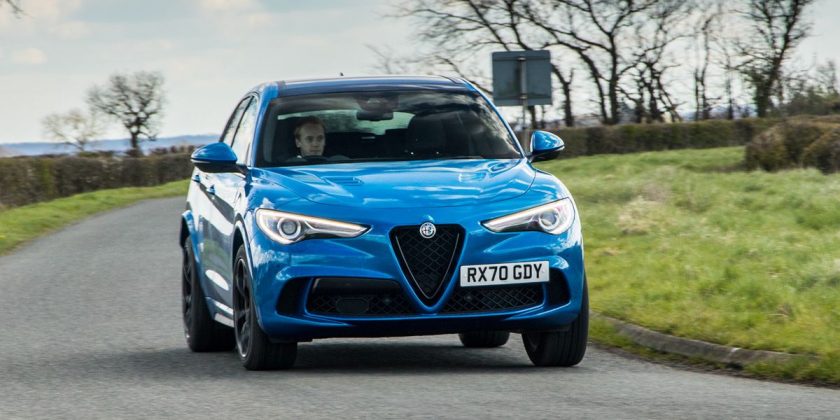
We’re now three months and about 800 miles into our Alfa Romeo Stelvio Quadrifoglio long-term drive. We haven’t been able to use it quite as much as we’d have liked, owing to a large chunk of our time with it being during the latest UK coronavirus lockdown, but we’ve had a decent crack of the whip nonetheless.
Here’s what’s stood out so far:
Physical dials are a joy

I remember how exciting it was when Audi revealed the current-generation TT in 2014 with its snazzy virtual cockpit. A digital instrument cluster on a relatively attainable car seemed like quite a landmark, but these days, the things are everywhere. And often, they’re not all that good.
So prevalent is the use of screens for gauges, that it’s become a novelty when you get a physical set. Particularly when they’re gorgeous set like those in the Stelvio Q, with on-point fonts, a neat 3D Cloverleaf badge on the speedometer and the classic Alfa Romeo script on the rev counter. Oh, and a dash of the Italian language for good measure.
Also in stark contrast to an increasing number of modern cars, you get proper physical buttons or dials for pretty much everything, including some chunky climate controls that are really easy to use. Far better than faffing around with a giant touchscreen.
As for the digital stuff, there’s a reasonably good infotainment system and a little multi-function screen between the dials. The best part about the latter? If you set it to the big speedo, the numbers rise and fall individually, unlike a lot of digital speedos which seem to miss out loads of digits if you’re accelerating hard.
It's very rear-biased

If you’ve used the brilliant DNA drive selector to engage either Dynamic or Race mode, the Stelvio Q often doesn’t seem particularly interested in being all-wheel drive. It happily sends gobfuls of power to the rear, and unlike a lot of modern systems, the setup doesn’t immediately send a load to the front end to neutralise the oversteer.
Some corrective lock is usually necessary, and that’s exactly the way it should be. It’s a tall, heavy thing, of course, so there is a slightly uneasy-feeling weight transfer to get used to when the Stelvio gets out of shape.
It's firm, but not unacceptably so

As we see on a lot of these uber SUVs, the Stelvio Q is firmly damped in all modes to offset it lofty ride height. It’s within the realms of acceptability, however, and even in the firmest of its three modes, the car doesn’t crash around on bumpier bits of road. Like a BMW X3 M.
Plus, it’s easy peasy to change the suspension firmness independently of the drive modes using the aforementioned DNA switch.
The exhaust note is the best thing about it
https://www.instagram.com/p/CN10yd8J0HJ/
Few modern cars see you finding excuses to slow down, dropping a few cogs and gunning it. Any journey that involves a national speed limit section becomes an event as you accelerate up to 60/70mph simply because of the wonderous noise that’s fired out of the Stelvio Q’s big exhaust pipes.
It’s a throaty, raspy kind of noise, enhanced by some rude upshift ‘farts’ to go with the eight-speed automatic gearbox’s surprisingly aggressive shifts. Thus far, Alfa has managed to avoid having to fit a petrol particulate filter (OPF) to either of the cars using this 2.9-litre V6. Hopefully, the (allegedly) Ferrari-derived unit will eschew such noise-tampering parts for a while longer.
The brake pedal is sharp and hard to modulate

Alfa Romeo is one of a few manufacturers using brake by wire technology in its cars. There are plenty of benefits to this – it’s a lighter setup, braking distances are shorter because pressure builds up faster, and ABS pedal judder is eliminated.
Some cars are pretty good at replicating the progressive feeling of a physical brake pedal, but the Stelvio and its Giulia cousin? Not so much. The brakes respond sharply to even light inputs, making smooth driving, particularly when you want to pull up gently at some traffic likes or a junction, quite difficult.
On the subject of the brakes, they also have a habit of making a squeaky racket when you’re pulling away or nudging forward in heavy traffic.
The V6 is a thirsty thing

The first 50 miles I did in the Stelvio involved bimbling around the local area on anything from 20mph residential roads to 70mph dual carriageways. And yes, downshifting and making lots of noise was still a novelty then. The damage? 13mpg.
Along with the power of a V8, the twin-turbo V6 also has the thirst of an eight-pot. On a long, boring motorway run, getting over 30mpg is impossible unless you want to set the cruise way below the speed limit. Realistically, the best distance MPG you can hope for is 26mpg.
We’ll be interested to see how the lower, lighter Giulia Quadfiroglio compares when we swap to it in the next month or so.
It's a little noisy at motorway speeds

A few weeks back we had a Ford Mustang Mach E in, which impressed us with how quiet it was at speed. Any NVH issues would be pretty damn obvious with no engine noise to mask them. The Stelvio on the other hand, even with a throaty V6 drowning stuff out, has a noticeable amount of wind noise when you’re going down a motorway at 70mph. Not awful, but you do expect more from a premium car like this.
This issue and the other foibles we’ve mentioned are fairly minor ones, though. So far, Alfa life has been pretty sweet.
Source: Read Full Article
